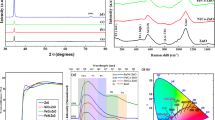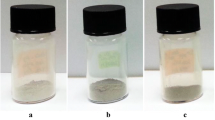Abstract
ZnO:Mn/ZnS nanocomposites were prepared by seed-mediated growth of ZnS QDs onto the preformed ZnO:Mn nanoparticles. The formation of the nanocomposite structure has been evidenced by XRD, HRTEM, and XPS. The architecture of the nanocomposite with outer ZnS QDs around ZnO:Mn cores is sustained by the sulfur and oxygen depth profiles resulted from XPS. When the two components are brought together, the band gap of ZnS component decreases while that of ZnO:Mn increases. It is the result of interface charge transfer from ZnO:Mn to ZnS QDs. Here ZnO:Mn valence states are extended through the interface into unoccupied gap states of ZnS. The energy band setup is modified from a type II into a type I band alignment. The process is accompanied by enhancement of composite UV emission of PL spectra as compared to its counterparts. The charge transfer from valence band also determines the increase of the core-polarization effect of s shell electrons at Mn2+ nucleus, thus determining the increase of the hyperfine field through the reduction of the covalency degree of Zn(Mn)–O bonds. The quantum confinement in ZnS QDs promotes the ferromagnetic coupling of singly occupied states due to Zn vacancies determining a superparamagnetic behavior of the ensemble. When the nanocomposites are formed, due to interface charge transfer effects, an increased number of filled cation vacancies in ZnS QDs develop, thus disrupting the pre-existing ferromagnetic coupling between spins resulting in a significant reduction of the overall saturation magnetization. The possibility to modulate nanocomposite properties by controlling the interface interactions may be foreseen in these types of materials.













Similar content being viewed by others
References
Anderson RL (1960) Germanium-gallium arsenide heterojunctions. IBM J Res Dev 4(3):283–287
Brillson LJ, Lu Y (2011) ZnO Schottky barriers and Ohmic contacts. J Appl Phys 109:121301
Cardona M, Weinstein M, Wolff GA (1965) Ultraviolet reflection spectrum of cubic CdS. Phys Rev 140:A633
Chen R, Huo L, Shi X, Bai R, Zhang Z, Zhao Y, Chang Y, Chen C (2014) Endoplasmic reticulum stress induced by zinc oxide nanoparticles is an earlier biomarker for nanotoxicological evaluation. ACS Nano 8(3):2562–2574
Cumpson PJ, Seah MP (1997) Elastic scattering corrections in AES and XPS. II. Estimating attenuation lengths and conditions required for their valid use in over layer/substrate experiments. Surf Interface Anal 25:430–446
Dabbousi BO, Rodriguez-Viejo J, Mikulec FV, Heine JR, Mattoussi H, Ober R, Jensen KF, Bawendi MG (1997) (CdSe) ZnS Core–shell quantum dots: synthesis and characterization of a size series of highly luminescent nanocrystallites. J Phys Chem B 101:9463–9475
Fang X, Zhai T, Gautam UK, Li L, Wu L, Bando Y, Golberg D (2011) ZnS nanostructures: from synthesis to applications. Prog Mater Sci 56:175–287
Gu X, Zhang S, Zhao Y, Qiang Y (2015) Band alignment of ZnO/ZnS heterojunction prepared through magnetron sputtering and measured by X-ray photoelectron spectroscopy. Vacuum 122:6–11
Guo J, Peng C (2015) Synthesis of ZnO nanoparticles with a novel combustion method and their C2H5OH gas sensing properties. Ceram Int 41:2180–2186
Hoa TTQ, The ND, McVitie S, Nam NH, Vu LV, Canh TD, Long NN (2011) Long optical properties of Mn-doped ZnS semiconductor nanoclusters synthesized by a hydrothermal process. Opt Mater 33:308–314
Huang X, Wang M, Willinger MG, Shao L, Su DS, Meng XM (2012) Assembly of three-dimensional hetero-epitaxial ZnO/ZnS core/shell nanorod and single crystalline hollow ZnS nanotube arrays. ACS Nano 6(8):7333–7339
Jain A, Panwar S, Kang RW, Kumar S (2013) Effect of zinc oxide concentration on the core-shell ZnS/ZnO nanocomposites. J Mater Sci Mater Electron 24:5147–5154
Jiang D, Cao L, Su G, Liu W, Qu H, Sun Y, Dong B (2009) Shell thickness dependence of luminescence intensity in core/shell ZnS:Mn/ZnS nanoparticles. Mater Chem Phys 115:795–798
Leostean C, Pana O, Turcu R, Soran ML, Macavei S, Chauvet O, Payen C (2011) Comparative study of core–shell iron/iron oxide gold covered magnetic nanoparticles obtained in different conditions. J Nanopart Res 13:6181–6192
Li J, Zhang JZ (2009) Optical properties and applications of hybrid semiconductor nanomaterials. Coord Chem Rev 253:3015–3041
Li J, Zhao D, Meng X, Zhang Z, Zhang J, Shen D, Lu Y, Fan X (2006) Enhanced ultraviolet emission from ZnS-coated ZnO nanowires fabricated by self-assembling method. J Phys Chem B 110:14685–14687
Limaye MV, Singh SB, Sadgopal K, Date RS, Kulkarni SK (2009) Epitaxially grown zinc-blende structured Mn doped ZnO nanoshell on ZnS nanoparticles. Mater Res Bull 44:339–344
Luo Y (2008) Versatile hydrothermal synthesis of one-dimensional composite structures. Solid State Commun 148:516–520
Mandal P, Singh A, Kasture S, Gopal AV, Vengurlekar AS (2011) Plasmon assisted intense blue–green emission from ZnO/ZnS nanocrystallites. Opt Mater 33:1786–1791
Mesaros A, Ghitulica CD, Popa M, Mereu R, Popa A, Petrisor T Jr, Gabor M, Cadis AI, Vasile BS (2014) Synthesis, structural and morphological characteristics, magnetic and optical properties of Co doped ZnO nanoparticles. Ceram Int 402:2835–2846
Mesaros A, Toloman D, Nasui M, Mos RB, Petrisor T, Vasile BS, Surdu VA, Perhaita I, Biris A, Pana O (2015) A valence states approach for luminescence enhancement by low dopant concentration in Eu-doped ZnO nanoparticles. J Mater Sci 50:6075–6086
Motaung DE, Kortidis I, Papadaki D, Nkosi SS, Mhlongo GH, Wesley-Smith J, Malgas GF, Mwakikunga BW, Coetsee E, Swart HC, Kiriakidis G, Ray SS (2014) Defect-induced magnetism in undoped and Mn-doped wide band gap zinc oxide grown by aerosol spray pyrolysis. Appl Surf Sci 311:14–26
Owens FJ (2005) Ferromagnetism above room temperature in bulk sintered gallium phosphide doped with manganese. Phys Chem Solids 66:793–796
Reddy AJ, Kokilab MK, Nagabhushanac H, Rao JL, Shivakumara C, Nagabhushanaf BM, Chakradhar RPS (2011) EPR, thermo and photoluminescence properties of ZnO nanopowders. Spectrochim Acta A 81:59–63
Sadollahkhani A, Nur O, Willander M, Kazeminezhad I, Khranovskyy V, Eriksson MO, Yakimova R, Holtz PO (2015) A detailed optical investigation of ZnO@ZnS core–shell nanoparticles and their photocatalytic activity at different pH values. Ceram Int 41:7174–7184
Saha S, Sarkar P (2013) Electronic structure of ZnO/ZnS core/shell quantum dots. Chem Phys Lett 555:191–195
Santra S, Yang H, Holloway PH, Stanley JT, Mericle RA (2005) Synthesis of water-dispersible fluorescent, radio-opaque, and paramagnetic CdS:Mn/ZnS quantum dots: a multifunctional probe for bioimaging. J Am Soc 127(6):1657–1658
Smith AM, Shuming N (2010) Semiconductor nanocrystals: structure, properties, and band gap engineering. Acc Chem Res 43:190–200
Sookhakian M, Amin YM, Basirun WJ, Tajabadi MT, Kamarulzaman N (2014) Synthesis, structural, and optical properties of type-II ZnO–ZnS core–shell nanostructure. J Lumin 145:244–252
Stefan M, Leostean C, Pana O, Soran ML, Suciu RC, Gautron E, Chauvet O (2014) Synthesis and characterization of Fe3O4@ZnS and Fe3O4@Au@ZnScore–shell nanoparticles. Appl Surf Sci 288:180–192
Tauc J (1971) Amorphous and liquid semiconductors. Plenum Press, London
Toloman D, Mesaros A, Popa A, Raita O, Silipas TD, Vasile BS, Pana O, Giurgiu LM (2013) Evidence by EPR of ferromagnetic phase in Mn-doped ZnO nanoparticles annealed at different temperatures. J Alloy Compd 551:502–507
Viswanatha R, Sapra S, Sen Gupta S, Satpati B, Satyam PV, Dev BN, Sarma DD (2004) Synthesis and characterization of Mn-doped ZnO nanocrystals. J Phys Chem B 108:6303–6310
Wang QP, Zhang DH, Xue ZY, Zhang XJ (2004) Mechanisms of green emission from ZnO films prepared by rf magnetron sputtering. Opt Mater 26:23–26
Wang SP, Shan CX, Zhu H, Li BH, Shen DZ, Liu XY, Tang ZK (2010) Phosphor-converted light-emitting diode based on ZnO-based heterojunction. J Lumin 130:2215–2217
Watson RE, Freeman AJ (1961) Origin of effective fields in magnetic materials. Phys Rev 123:2027–2047
Wood A, Giersig M, Hilgendorff M, Vilas-Campos A, Liz-Marzan LM, Mulvaney P (2003) Size effects in ZnO: the cluster to quantum dot transition. Aust J Chem 56:1056–1058
Xiao Q, Xiao C (2008) Synthesis and photoluminescence of water-soluble Mn:ZnS/ZnS core/shell quantum dots using nucleation-doping strategy. Opt Mater 3:455–460
Yang Y, Xue S, Liu S, Huang J, Shen J (1996) Fabrication and characteristics of ZnS nanocrystals/polymer composite doped with tetraphenylbenzidine single layer structure light-emitting diode. Appl Phys Lett 69:377
Yang Y, Chen O, Angerhofer A, Cao YC (2008) On doping CdS/ZnS core/shell nanocrystals with Mn. J Am Chem Soc 130:15649–15661
Yi R, Qiu G, Liu X (2009) Rational synthetic strategy: from ZnO nanorods to ZnS nanotubes. J Solid State Chem 182:2791–2795
Zhang XT, Liu YC, Zhang JY, Lu YM, Shen DZ, Fan XW, Kong XG (2003) Structure and photoluminescence of Mn-passivated nanocrystalline ZnO thin films. J Cryst Growth 254:80–85
Zhang Y, Qin H, Bao Y, Hu J (2011) Study of ferromagnetism in Bi2S3 and ZnS nanocrystalline powders. Phys B 406:4661–4665
Acknowledgments
This work was supported by the Romanian National Council for Scientific Research within the Projects: PNII-ID-PCE-2011-3-0876 (ID 119/2011) and PNII-RU-PD-2012-3-0466 (PD 25/2013). Also, this paper is supported by Postdoctoral Programme POSDRU/159/1.5/S/137516 and POSDRU/159/1.5/S/134398 Projects co-funded by European Social Fund through the Human Resources Sectorial Operational Program 2007–2013 and CNCSIS-UEFISCSU.
Author information
Authors and Affiliations
Corresponding author
Rights and permissions
About this article
Cite this article
Stefan, M., Toloman, D., Popa, A. et al. Interface charge transfer process in ZnO:Mn/ZnS nanocomposites. J Nanopart Res 18, 59 (2016). https://doi.org/10.1007/s11051-016-3369-2
Received:
Accepted:
Published:
DOI: https://doi.org/10.1007/s11051-016-3369-2




